transmission OPEL GT-R 1973 Manual PDF
[x] Cancel search | Manufacturer: OPEL, Model Year: 1973, Model line: GT-R, Model: OPEL GT-R 1973Pages: 625, PDF Size: 17.22 MB
Page 405 of 625
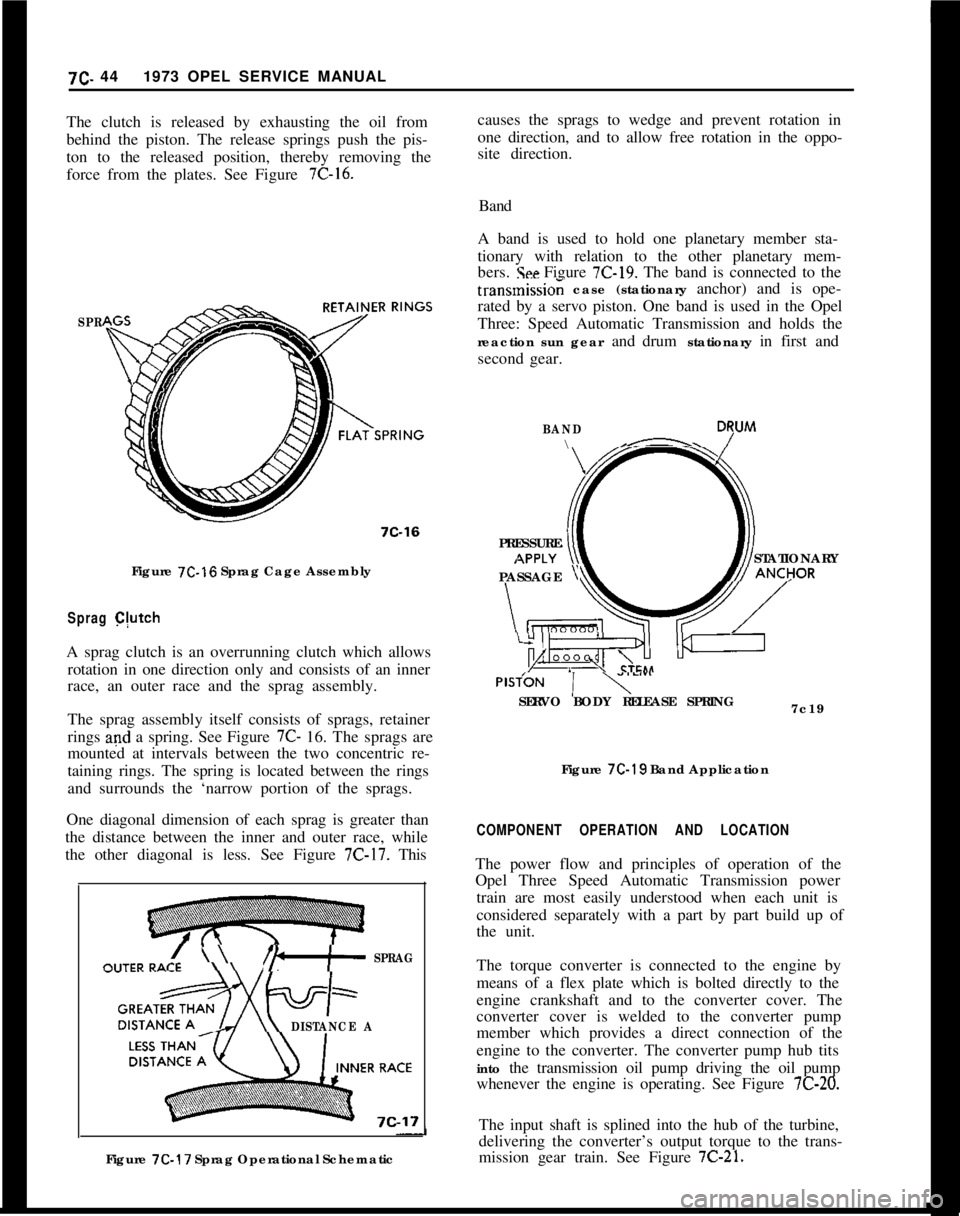
causes the sprags to wedge and prevent rotation in
one direction, and to allow free rotation in the oppo-
site direction.7C. 441973 OPEL SERVICE MANUAL
The clutch is released by exhausting the oil from
behind the piston. The release springs push the pis-
ton to the released position, thereby removing the
force from the plates. See Figure 7C-16.Band
A band is used to hold one planetary member sta-
tionary with relation to the other planetary mem-
bers.
!See Figure 7C-19. The band is connected to the
SPR
7C-16Figure
7C-16 Sprag Cage Assembly
Sprag C(utchA sprag clutch is an overrunning clutch which allows
rotation in one direction only and consists of an inner
race, an outer race and the sprag assembly.
The sprag assembly itself consists of sprags, retainer
rings and a spring. See Figure 7C- 16. The sprags are
mounted at intervals between the two concentric re-
taining rings. The spring is located between the rings
and surrounds the ‘narrow portion of the sprags.
One diagonal dimension of each sprag is greater than
the distance between the inner and outer race, while
the other diagonal is less. See Figure
7C-17. This
\ \I’b+ SPRAG
DISTANCE AFigure
7C-17 Sprag Operational Schematictransmissio; case (stationary anchor) and is ope-
rated by a servo piston. One band is used in the Opel
Three: Speed Automatic Transmission and holds the
reaction sun gear and drum stationary in first and
second gear.
BAND\- D7uM
PRESSURE
STATIONARY
PASSAGE
yPlSfON
1 y””SERVO BODY RELEASE SPRING
7c19
Figure
7C-19 Band Application
COMPONENT OPERATION AND LOCATIONThe power flow and principles of operation of the
Opel Three Speed Automatic Transmission power
train are most easily understood when each unit is
considered separately with a part by part build up of
the unit.
The torque converter is connected to the engine by
means of a flex plate which is bolted directly to the
engine crankshaft and to the converter cover. The
converter cover is welded to the converter pump
member which provides a direct connection of the
engine to the converter. The converter pump hub tits
into the transmission oil pump driving the oil pump
whenever the engine is operating. See Figure
7C-20.The input shaft is splined into the hub of the turbine,
delivering the converter’s output torque to the trans-
mission gear train. See Figure
7C-21.
Page 406 of 625
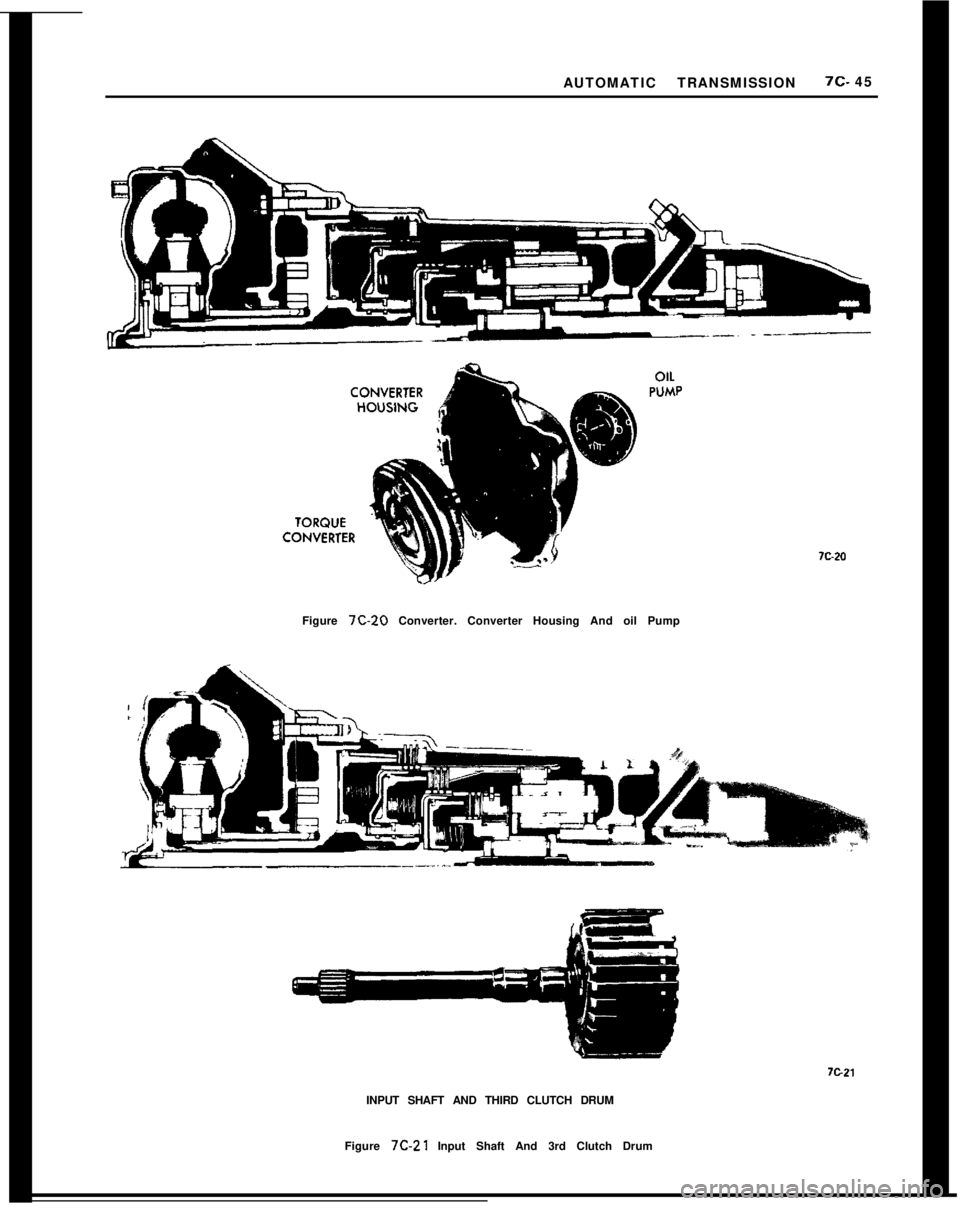
AUTOMATIC TRANSMISSION7c- 45
Figure 7C-20 Converter. Converter Housing And oil Pump
INPUT SHAFT AND THIRD CLUTCH DRUM
Figure 7C-21 Input Shaft And 3rd Clutch Drum
Page 407 of 625
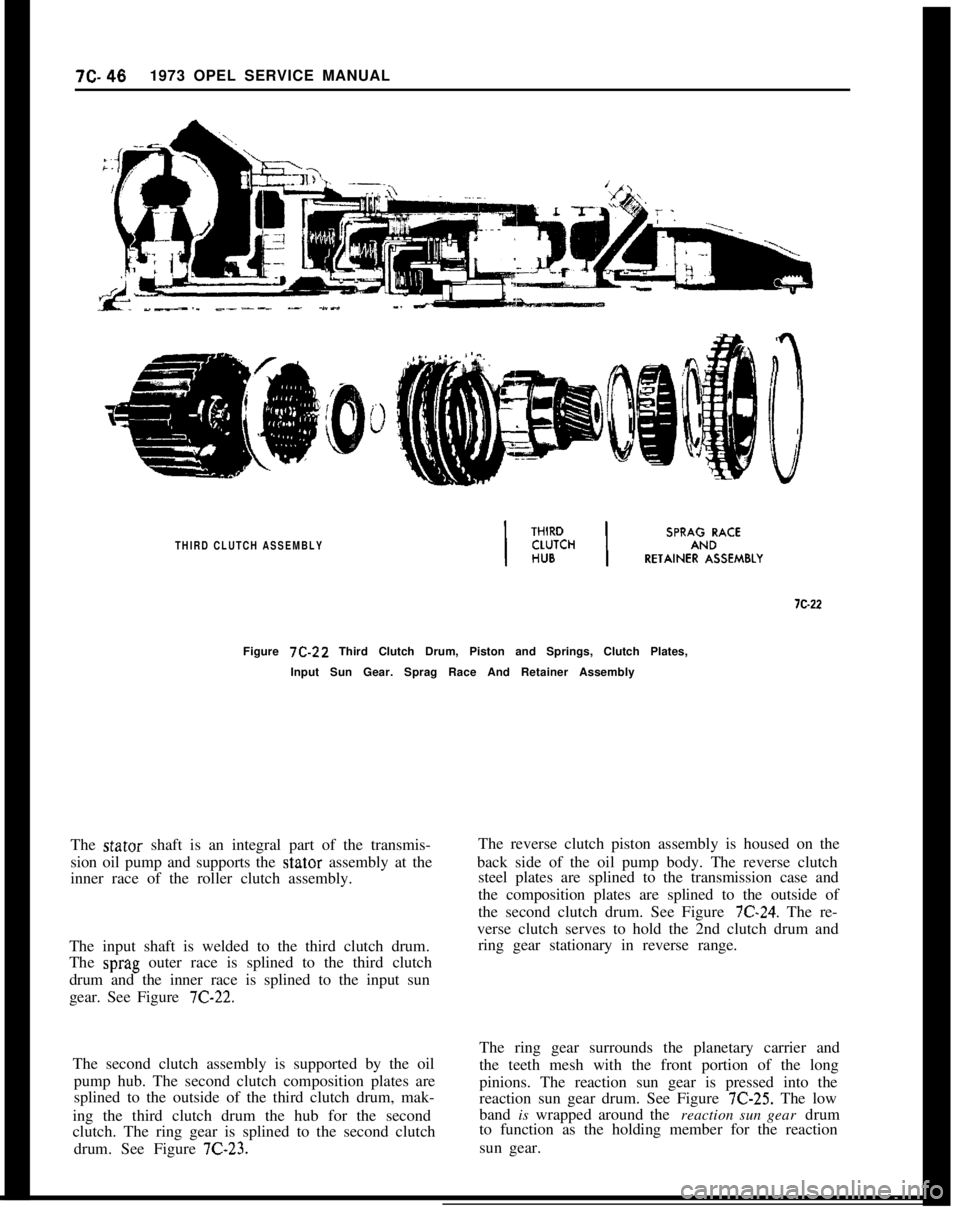
712.461973 OPEL SERVICE MANUAL___-.. _~--- ..- -_.-. -
THIRD CLUTCH ASSEMBLY7D22
Figure 7C-22 Third Clutch Drum, Piston and Springs, Clutch Plates,
Input Sun Gear. Sprag Race And Retainer Assembly
The stator shaft is an integral part of the transmis-
sion oil pump and supports the stator assembly at the
inner race of the roller clutch assembly.
The input shaft is welded to the third clutch drum.
The sprag outer race is splined to the third clutch
drum and the inner race is splined to the input sun
gear. See Figure
7C-22.The second clutch assembly is supported by the oil
pump hub. The second clutch composition plates are
splined to the outside of the third clutch drum, mak-
ing the third clutch drum the hub for the second
clutch. The ring gear is splined to the second clutch
drum. See Figure
7C-23.The reverse clutch piston assembly is housed on the
back side of the oil pump body. The reverse clutch
steel plates are splined to the transmission case and
the composition plates are splined to the outside of
the second clutch drum. See Figure
7C-24. The re-
verse clutch serves to hold the 2nd clutch drum and
ring gear stationary in reverse range.
The ring gear surrounds the planetary carrier and
the teeth mesh with the front portion of the long
pinions. The reaction sun gear is pressed into the
reaction sun gear drum. See Figure
7C-25. The low
band is wrapped around the reaction sun gear drum
to function as the holding member for the reaction
sun gear.
Page 408 of 625
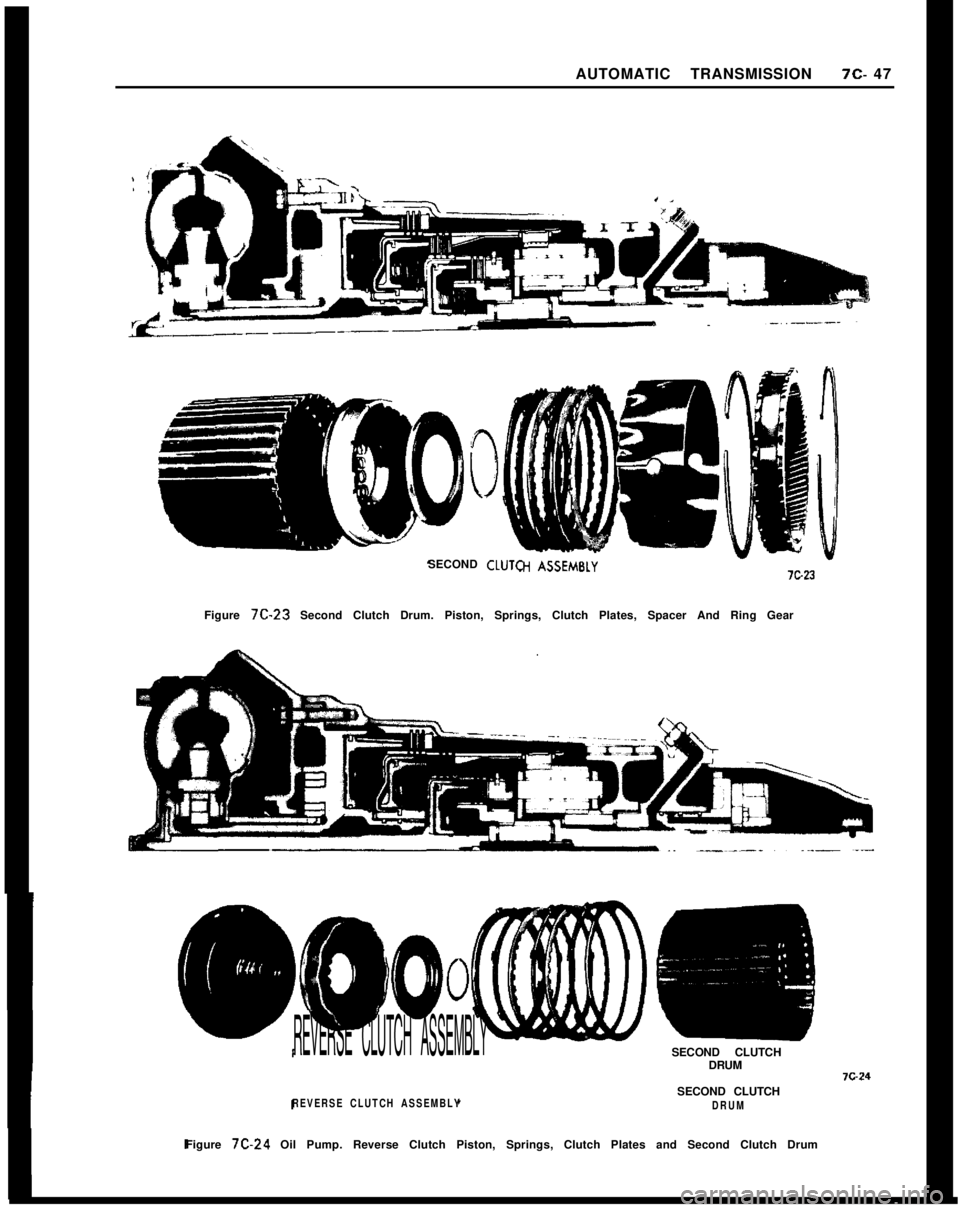
AUTOMATIC TRANSMISSION7c- 47
SECOND CtUTC7cz3
Figure 7C.23 Second Clutch Drum. Piston, Springs, Clutch Plates, Spacer And Ring Gear
REVERSE CLUTCH ASSEMBLYSECOND CLUTCH
DRUM
SECOND CLUTCH
REVERSE CLUTCH ASSEMBLY
DRUMFigure 7C-24 Oil Pump. Reverse Clutch Piston, Springs, Clutch Plates and Second Clutch Drum
Page 409 of 625
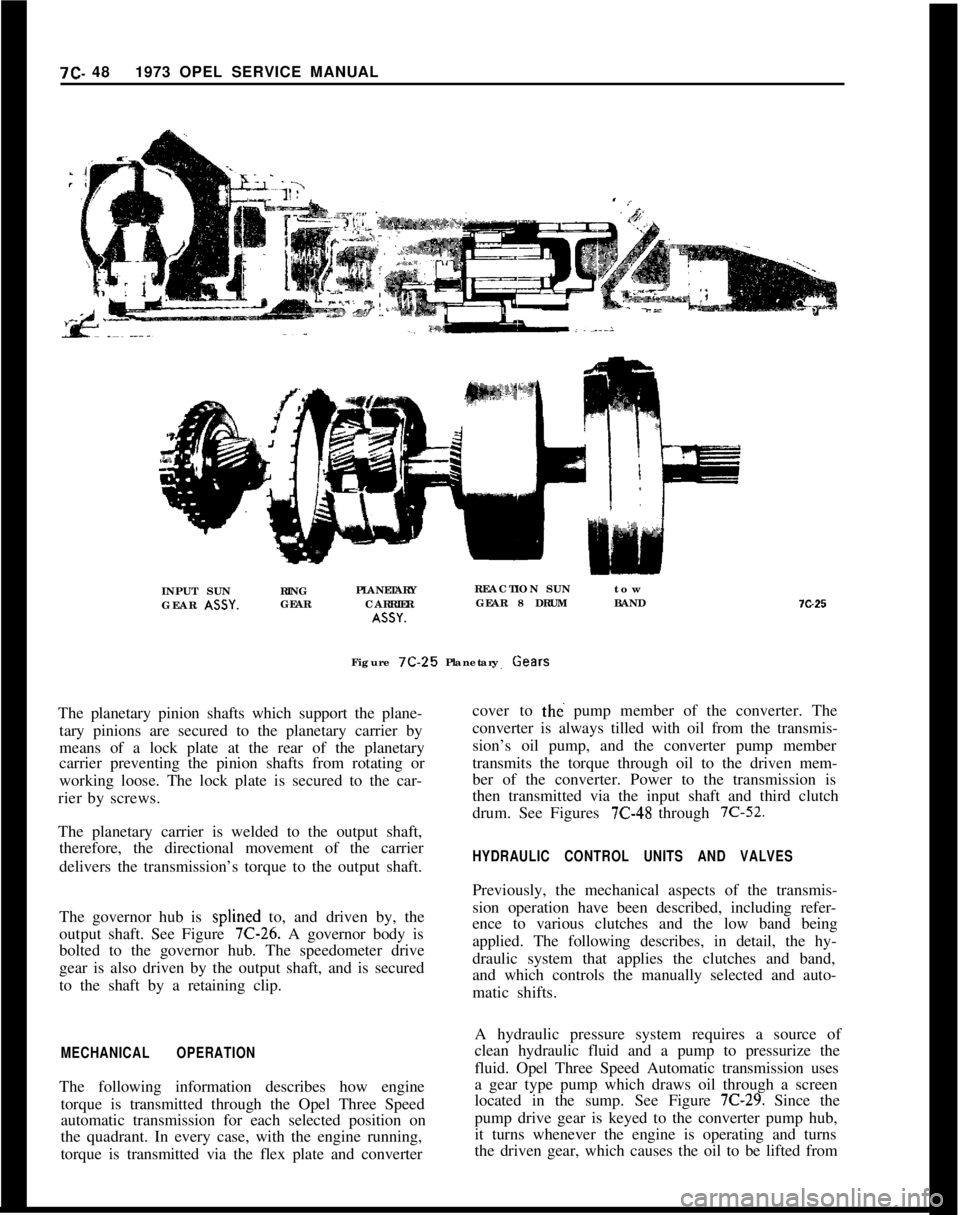
7C- 481973 OPEL SERVICE MANUAL
INPUT SUNRING
GEAR ASSY.GEARPLANETARY
CARRIERASSY.REACTION SUNtow
GEAR 8 DRUMBAND
Figure 7C-25Planetary Gears
The planetary pinion shafts which support the plane-
tary pinions are secured to the planetary carrier by
means of a lock plate at the rear of the planetary
carrier preventing the pinion shafts from rotating or
working loose. The lock plate is secured to the car-
rier by screws.
The planetary carrier is welded to the output shaft,
therefore, the directional movement of the carrier
delivers the transmission’s torque to the output shaft.
The governor hub is splined to, and driven by, the
output shaft. See Figure 7C-26. A governor body is
bolted to the governor hub. The speedometer drive
gear is also driven by the output shaft, and is secured
to the shaft by a retaining clip.
MECHANICAL OPERATIONThe following information describes how engine
torque is transmitted through the Opel Three Speed
automatic transmission for each selected position on
the quadrant. In every case, with the engine running,
torque is transmitted via the flex plate and converter7G25
cover to
tht? pump member of the converter. The
converter is always tilled with oil from the transmis-
sion’s oil pump, and the converter pump member
transmits the torque through oil to the driven mem-
ber of the converter. Power to the transmission is
then transmitted via the input shaft and third clutch
drum. See Figures
7C-48 through 7C-52.
HYDRAULIC CONTROL UNITS AND VALVESPreviously, the mechanical aspects of the transmis-
sion operation have been described, including refer-
ence to various clutches and the low band being
applied. The following describes, in detail, the hy-
draulic system that applies the clutches and band,
and which controls the manually selected and auto-
matic shifts.
A hydraulic pressure system requires a source of
clean hydraulic fluid and a pump to pressurize the
fluid. Opel Three Speed Automatic transmission uses
a gear type pump which draws oil through a screen
located in the sump. See Figure
7C-29. Since the
pump drive gear is keyed to the converter pump hub,
it turns whenever the engine is operating and turns
the driven gear, which causes the oil to be lifted from
Page 410 of 625
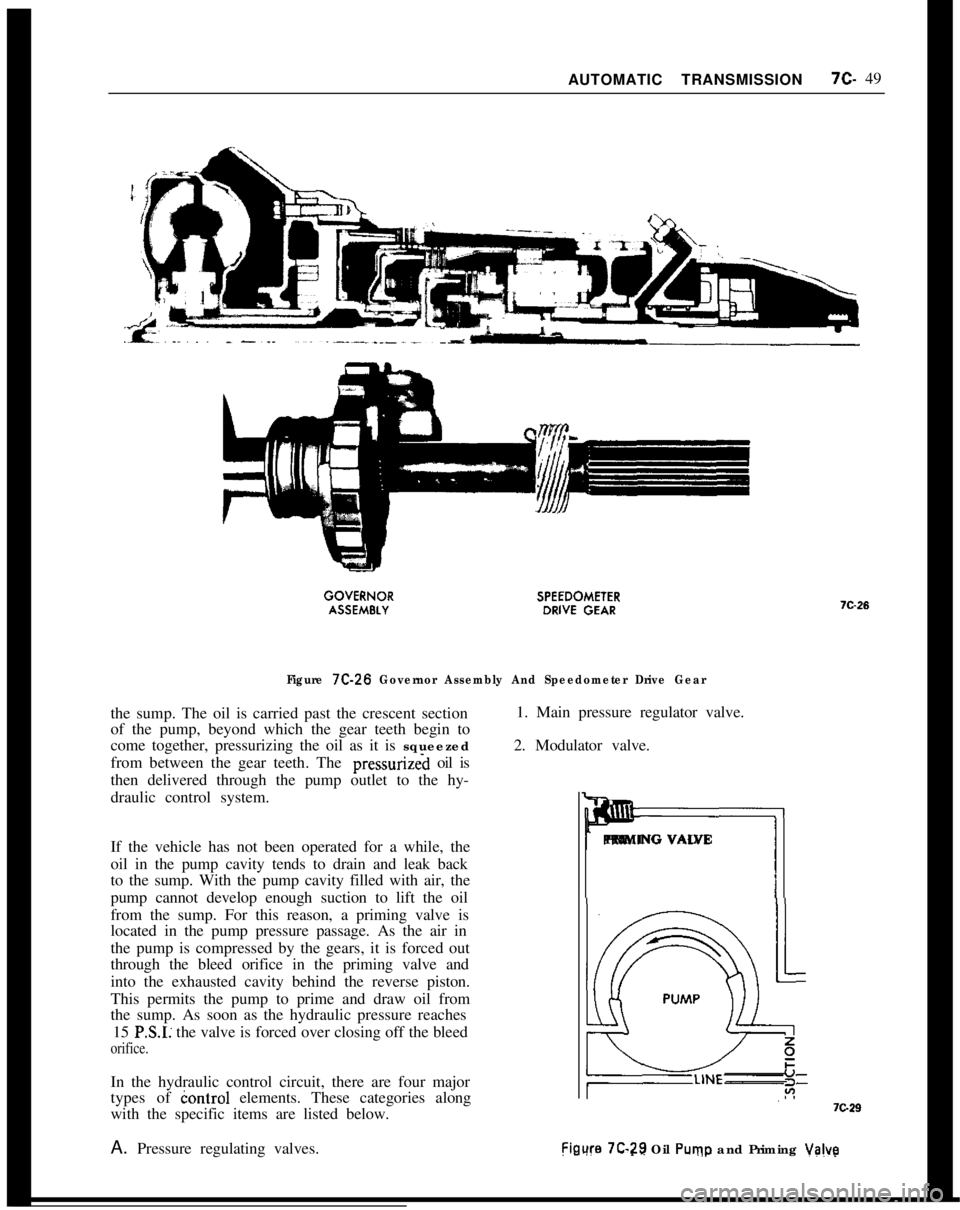
AUTOMATIC TRANSMISSION7c- 49Figure 7C-26 Governor Assembly And Speedometer Drive Gearthe sump. The oil is carried past the crescent section
of the pump, beyond which the gear teeth begin to
come together, pressurizing the oil as it is squeezed
from between the gear teeth. The pressurizeh oil is
then delivered through the pump outlet to the hy-
draulic control system.1. Main pressure regulator valve.
2. Modulator valve.
mPRIMING VALVE
If the vehicle has not been operated for a while, the
oil in the pump cavity tends to drain and leak back
to the sump. With the pump cavity filled with air, the
pump cannot develop enough suction to lift the oil
from the sump. For this reason, a priming valve is
located in the pump pressure passage. As the air in
the pump is compressed by the gears, it is forced out
through the bleed orifice in the priming valve and
into the exhausted cavity behind the reverse piston.
This permits the pump to prime and draw oil from
the sump. As soon as the hydraulic pressure reaches
15
PSI: the valve is forced over closing off the bleed
orifice.PRIMING VALVE
In the hydraulic control circuit, there are four major
types of iontrol elements. These categories along
with the specific items are listed below.
A. Pressure regulating valves.
Fieure 7C-7.9 Oil Puvp and Priming Valve
Page 412 of 625
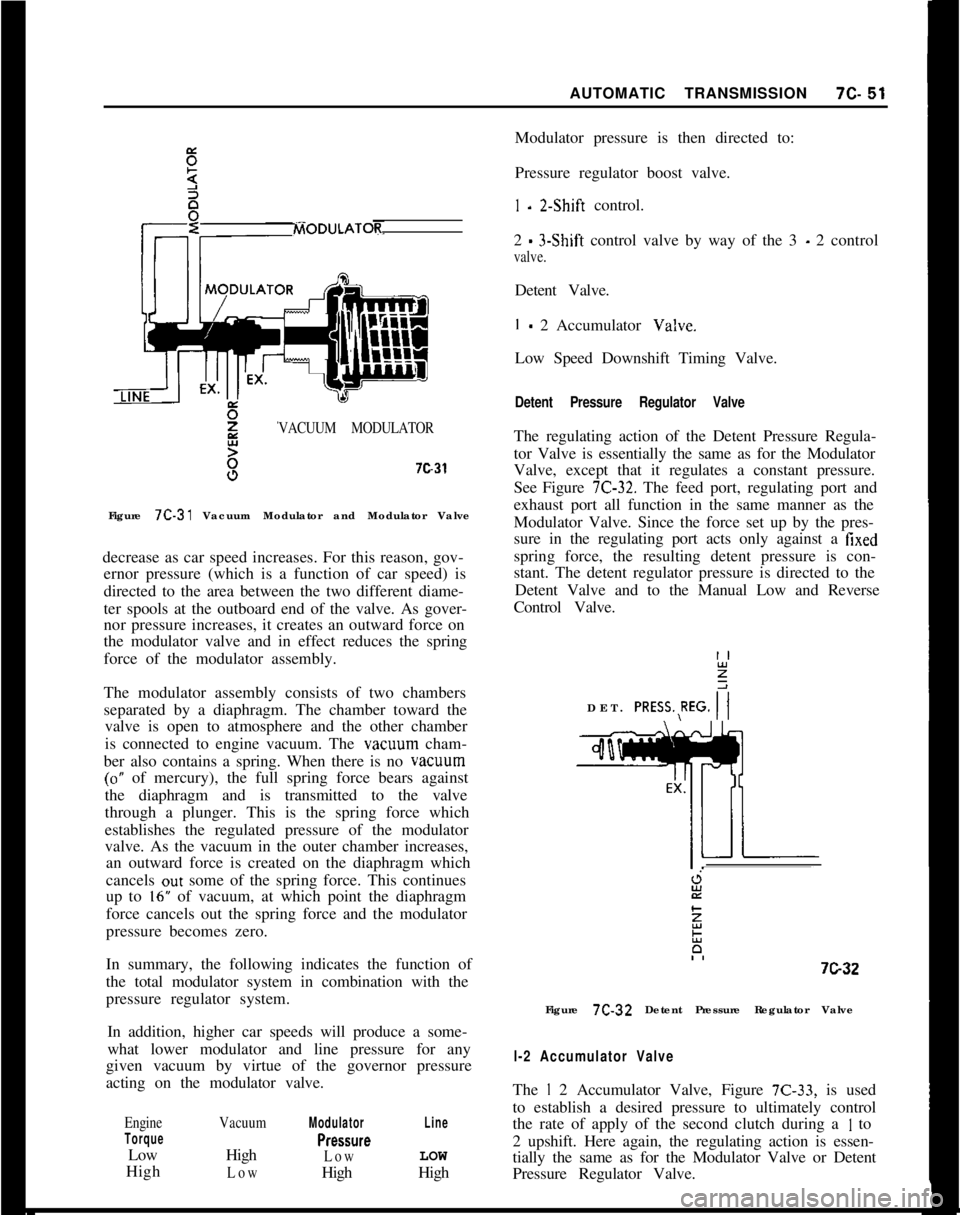
AUTOMATIC TRANSMISSION7c-51VACUUM MODULATOR7c31
Figure 7C-31 Vacuum Modulator and Modulator Valve
decrease as car speed increases. For this reason, gov-
ernor pressure (which is a function of car speed) is
directed to the area between the two different diame-
ter spools at the outboard end of the valve. As gover-
nor pressure increases, it creates an outward force on
the modulator valve and in effect reduces the spring
force of the modulator assembly.
The modulator assembly consists of two chambers
separated by a diaphragm. The chamber toward the
valve is open to atmosphere and the other chamber
is connected to engine vacuum. The vacwm cham-
ber also contains a spring. When there is no vacuum
(0” of mercury), the full spring force bears against
the diaphragm and is transmitted to the valve
through a plunger. This is the spring force which
establishes the regulated pressure of the modulator
valve. As the vacuum in the outer chamber increases,
an outward force is created on the diaphragm which
cancels out some of the spring force. This continues
up to
16” of vacuum, at which point the diaphragm
force cancels out the spring force and the modulator
pressure becomes zero.
In summary, the following indicates the function of
the total modulator system in combination with the
pressure regulator system.
In addition, higher car speeds will produce a some-
what lower modulator and line pressure for any
given vacuum by virtue of the governor pressure
acting on the modulator valve.
Engine
TorqueLow
High
VacuumHigh
Low
Modulator
PreSSWe
LowHigh
LineLOW
HighModulator pressure is then directed to:
Pressure regulator boost valve.
I - 2.Shift control.
2
- 3-Shift control valve by way of the 3 - 2 control
valve.Detent Valve.
I - 2 Accumulator Va!ve.
Low Speed Downshift Timing Valve.
Detent Pressure Regulator ValveThe regulating action of the Detent Pressure Regula-
tor Valve is essentially the same as for the Modulator
Valve, except that it regulates a constant pressure.
See Figure
7C-32. The feed port, regulating port and
exhaust port all function in the same manner as the
Modulator Valve. Since the force set up by the pres-
sure in the regulating port acts only against a
fixedspring force, the resulting detent pressure is con-
stant. The detent regulator pressure is directed to the
Detent Valve and to the Manual Low and Reverse
Control Valve.
DET. PRESS.,REG.
i7G3-2
Figure 7C-32 Detent Pressure Regulator Valve
l-2 Accumulator ValveThe
I 2 Accumulator Valve, Figure 7C-33, is used
to establish a desired pressure to ultimately control
the rate of apply of the second clutch during a
I to
2 upshift. Here again, the regulating action is essen-
tially the same as for the Modulator Valve or Detent
Pressure Regulator Valve.
Page 414 of 625
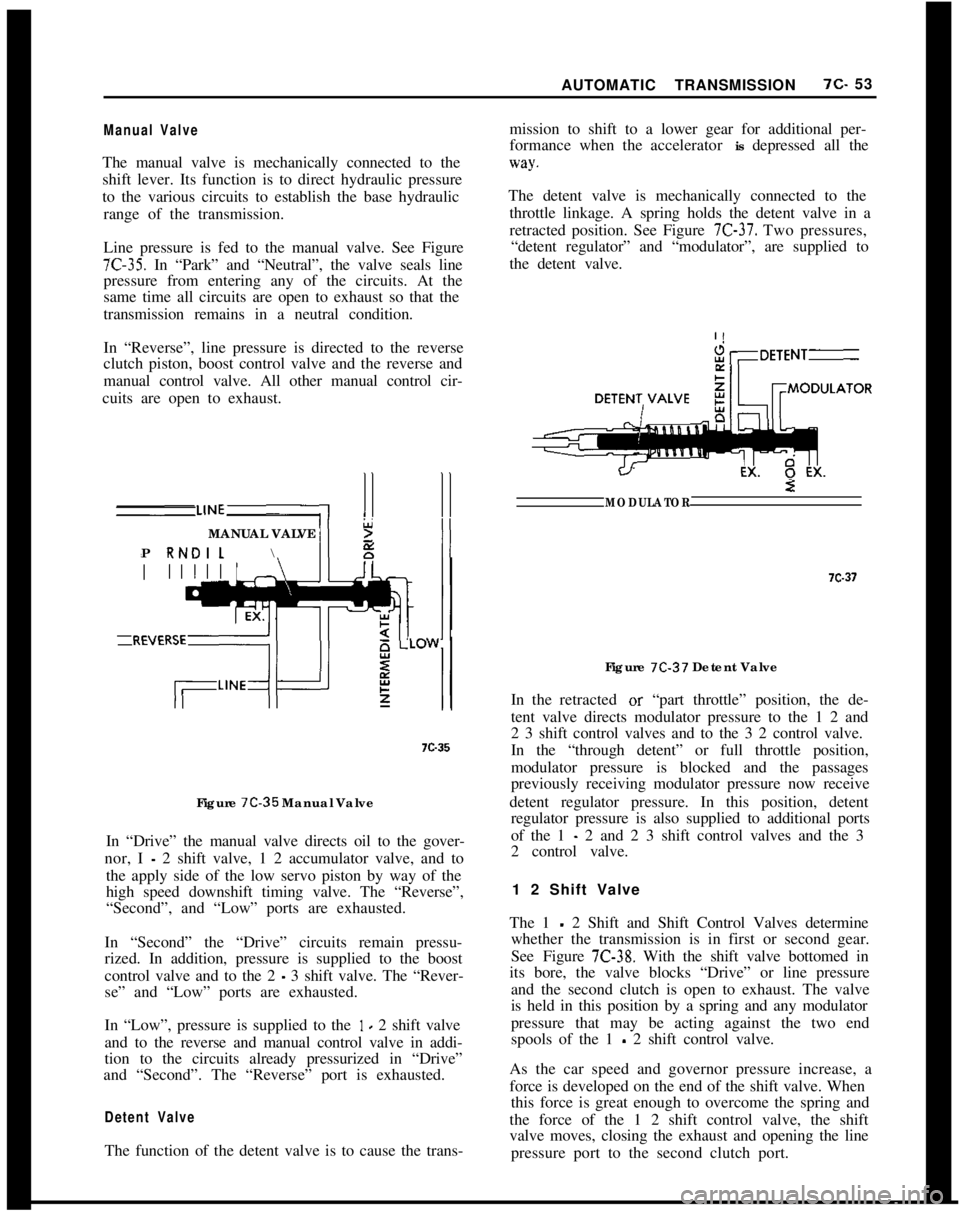
AUTOMATIC TRANSMISSIONlC- 53
Manual ValveThe manual valve is mechanically connected to the
shift lever. Its function is to direct hydraulic pressure
to the various circuits to establish the base hydraulic
range of the transmission.
Line pressure is fed to the manual valve. See Figure
7C-35. In “Park” and “Neutral”, the valve seals line
pressure from entering any of the circuits. At the
same time all circuits are open to exhaust so that the
transmission remains in a neutral condition.
In “Reverse”, line pressure is directed to the reverse
clutch piston, boost control valve and the reverse and
manual control valve. All other manual control cir-
cuits are open to exhaust.
MANUAL VALVE
;i
\2
P RNDILII7D35
Figure
7C-35 Manual Valve
In “Drive” the manual valve directs oil to the gover-
nor, I
- 2 shift valve, 1 2 accumulator valve, and to
the apply side of the low servo piston by way of the
high speed downshift timing valve. The “Reverse”,
“Second”, and “Low” ports are exhausted.
In “Second” the “Drive” circuits remain pressu-
rized. In addition, pressure is supplied to the boost
control valve and to the 2
- 3 shift valve. The “Rever-
se” and “Low” ports are exhausted.
In “Low”, pressure is supplied to the
1 - 2 shift valve
and to the reverse and manual control valve in addi-
tion to the circuits already pressurized in “Drive”
and “Second”. The “Reverse” port is exhausted.
Detent ValveThe function of the detent valve is to cause the trans-mission to shift to a lower gear for additional per-
formance when the accelerator is depressed all the
way.The detent valve is mechanically connected to the
throttle linkage. A spring holds the detent valve in a
retracted position. See Figure
7C-37. Two pressures,
“detent regulator” and “modulator”, are supplied to
the detent valve.
iiiDETENTE2
MODULATORFigure
7C-37 Detent Valve
In the retracted or “part throttle” position, the de-
tent valve directs modulator pressure to the 1 2 and
2 3 shift control valves and to the 3 2 control valve.
In the “through detent” or full throttle position,
modulator pressure is blocked and the passages
previously receiving modulator pressure now receive
detent regulator pressure. In this position, detent
regulator pressure is also supplied to additional ports
of the 1
- 2 and 2 3 shift control valves and the 3
2 control valve.
1 2 Shift Valve
The 1
- 2 Shift and Shift Control Valves determine
whether the transmission is in first or second gear.
See Figure
7C-38. With the shift valve bottomed in
its bore, the valve blocks “Drive” or line pressure
and the second clutch is open to exhaust. The valve
is held in this position by a spring and any modulator
pressure that may be acting against the two end
spools of the 1
- 2 shift control valve.
As the car speed and governor pressure increase, a
force is developed on the end of the shift valve. When
this force is great enough to overcome the spring and
the force of the 1 2 shift control valve, the shift
valve moves, closing the exhaust and opening the line
pressure port to the second clutch port.
Page 415 of 625
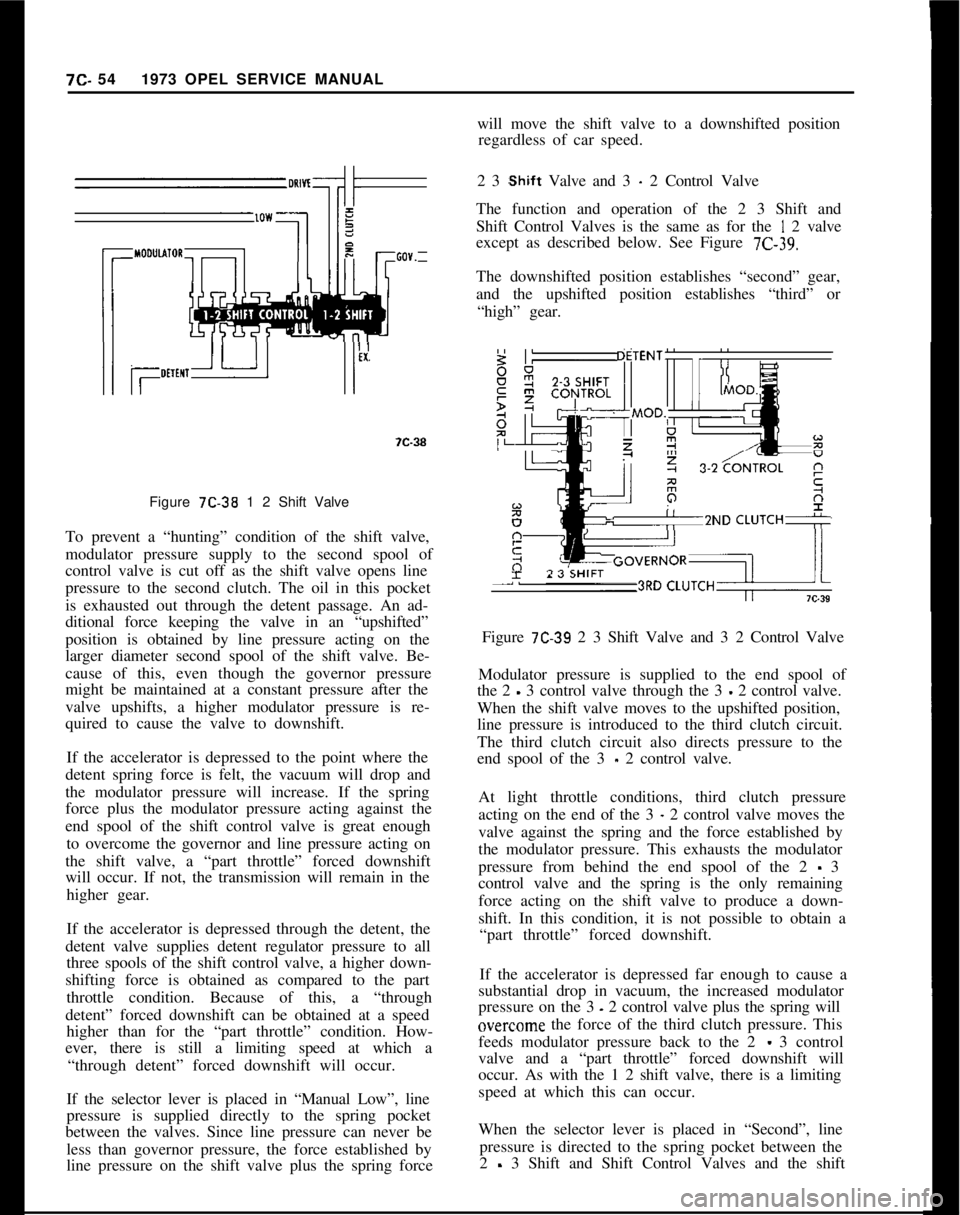
7C- 541973 OPEL SERVICE MANUAL
Figure 7C-38 1 2 Shift Valve
To prevent a “hunting” condition of the shift valve,
modulator pressure supply to the second spool of
control valve is cut off as the shift valve opens line
pressure to the second clutch. The oil in this pocket
is exhausted out through the detent passage. An ad-
ditional force keeping the valve in an “upshifted”
position is obtained by line pressure acting on the
larger diameter second spool of the shift valve. Be-
cause of this, even though the governor pressure
might be maintained at a constant pressure after the
valve upshifts, a higher modulator pressure is re-
quired to cause the valve to downshift.
If the accelerator is depressed to the point where the
detent spring force is felt, the vacuum will drop and
the modulator pressure will increase. If the spring
force plus the modulator pressure acting against the
end spool of the shift control valve is great enough
to overcome the governor and line pressure acting on
the shift valve, a “part throttle” forced downshift
will occur. If not, the transmission will remain in the
higher gear.
If the accelerator is depressed through the detent, the
detent valve supplies detent regulator pressure to all
three spools of the shift control valve, a higher down-
shifting force is obtained as compared to the part
throttle condition. Because of this, a “through
detent” forced downshift can be obtained at a speed
higher than for the “part throttle” condition. How-
ever, there is still a limiting speed at which a
“through detent” forced downshift will occur.
If the selector lever is placed in “Manual Low”, line
pressure is supplied directly to the spring pocket
between the valves. Since line pressure can never be
less than governor pressure, the force established by
line pressure on the shift valve plus the spring forcewill move the shift valve to a downshifted position
regardless of car speed.
2 3
,Shift Valve and 3 - 2 Control Valve
The function and operation of the 2 3 Shift and
Shift Control Valves is the same as for the
I 2 valve
except as described below. See Figure
7C-39.The downshifted position establishes “second” gear,
and the upshifted position establishes “third” or
“high” gear.
~ZND CLUTCH*
-I.Figure
7C-39 2 3 Shift Valve and 3 2 Control Valve
Modulator pressure is supplied to the end spool of
the 2
- 3 control valve through the 3 - 2 control valve.
When the shift valve moves to the upshifted position,
line pressure is introduced to the third clutch circuit.
The third clutch circuit also directs pressure to the
end spool of the 3
- 2 control valve.
At light throttle conditions, third clutch pressure
acting on the end of the 3
- 2 control valve moves the
valve against the spring and the force established by
the modulator pressure. This exhausts the modulator
pressure from behind the end spool of the 2
- 3
control valve and the spring is the only remaining
force acting on the shift valve to produce a down-
shift. In this condition, it is not possible to obtain a
“part throttle” forced downshift.
If the accelerator is depressed far enough to cause a
substantial drop in vacuum, the increased modulator
pressure on the 3
- 2 control valve plus the spring will
overc,ome the force of the third clutch pressure. This
feeds modulator pressure back to the 2
- 3 control
valve and a “part throttle” forced downshift will
occur. As with the 1 2 shift valve, there is a limiting
speed at which this can occur.
When the selector lever is placed in “Second”, line
pressure is directed to the spring pocket between the
2
- 3 Shift and Shift Control Valves and the shift
Page 416 of 625
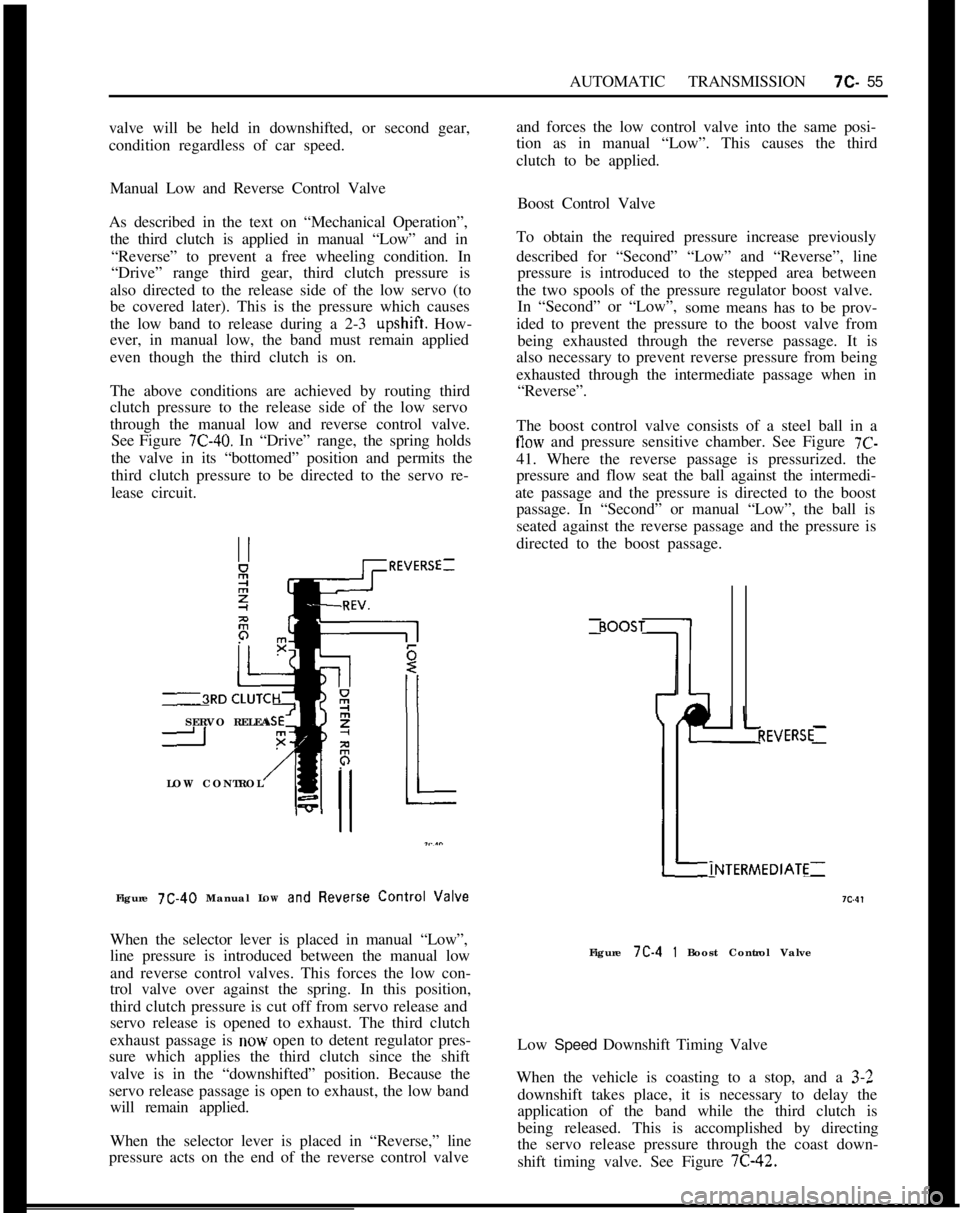
AUTOMATIC TRANSMISSION7c- 55
valve will be held in downshifted, or second gear,
condition regardless of car speed.
Manual Low and Reverse Control Valve
As described in the text on “Mechanical Operation”,
the third clutch is applied in manual “Low” and in
“Reverse” to prevent a free wheeling condition. In
“Drive” range third gear, third clutch pressure is
also directed to the release side of the low servo (to
be covered later). This is the pressure which causes
the low band to release during a 2-3 upshift. How-
ever, in manual low, the band must remain applied
even though the third clutch is on.
The above conditions are achieved by routing third
clutch pressure to the release side of the low servo
through the manual low and reverse control valve.
See Figure 7C-40. In “Drive” range, the spring holds
the valve in its “bottomed” position and permits the
third clutch pressure to be directed to the servo re-
lease circuit.
_~RDSERVO RELEA
ILOW CONTROL
Figure 7C-40 Manual LOW
and Ftever~e Control Valve
When the selector lever is placed in manual “Low”,
line pressure is introduced between the manual low
and reverse control valves. This forces the low con-
trol valve over against the spring. In this position,
third clutch pressure is cut off from servo release and
servo release is opened to exhaust. The third clutch
exhaust passage is now open to detent regulator pres-
sure which applies the third clutch since the shift
valve is in the “downshifted” position. Because the
servo release passage is open to exhaust, the low band
will remain applied.
When the selector lever is placed in “Reverse,” line
pressure acts on the end of the reverse control valveand forces the low control valve into the same posi-
tion as in manual “Low”. This causes the third
clutch to be applied.
Boost Control Valve
To obtain the required pressure increase previously
described for “Second” “Low” and “Reverse”, line
pressure is introduced to the stepped area between
the two spools of the pressure regulator boost valve.
In “Second” or “Low”,
some means has to be prov-
ided to prevent the pressure to the boost valve from
being exhausted through the reverse passage. It is
also necessary to prevent reverse pressure from being
exhausted through the intermediate passage when in
“Reverse”.
The boost control valve consists of a steel ball in a
flow and pressure sensitive chamber. See Figure 7C-41. Where the reverse passage is pressurized. the
pressure and flow seat the ball against the intermedi-
ate passage and the pressure is directed to the boost
passage. In “Second” or manual “Low”, the ball is
seated against the reverse passage and the pressure is
directed to the boost passage.
t-INTERMEDIATE
7c.4,
I I
REVERSE:Figure 7C-4
1 Boost Control Valve
Low Speed Downshift Timing Valve
When the vehicle is coasting to a stop, and a
3-2downshift takes place, it is necessary to delay the
application of the band while the third clutch is
being released. This is accomplished by directing
the servo release pressure through the coast down-
shift timing valve. See Figure 7C-42.